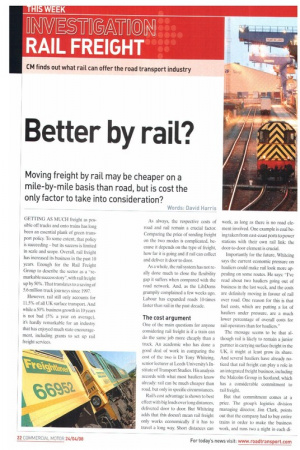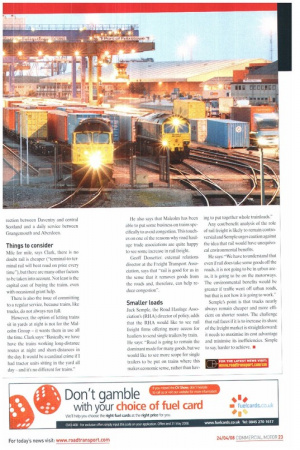Better by rail?
Page 22

Page 23

If you've noticed an error in this article please click here to report it so we can fix it.
Moving freight by rail may be cheaper on a mile-by-mile basis than road, but is cost the only factor to take into consideration?
Words: David Harris
GETTING AS MUCH freight as possible off trucks and onto trains has long been an essential plank of green transport policy. To some extent, that policy is succeeding — but its success is limited in scale and scope. Overall, rail freight has increased its business in the past 10 years. Enough for the Rail Freight Group to describe the sector as a "remarkable success story", with rail freight up by 50% .That translates to a saving of 5.6 million truck journeys since 1997.
However, rail still only accounts for 11.5% of all UK surface transport. And while a 50% business growth in 10 years is not bad (5% a year on average), it's hardly remarkable for an industry that has enjoyed much state encouragement, including grants to set up rail freight services. As always, the respective costs of road and rail remain a crucial factor. Comparing the price of sending freight on the two modes is complicated, because it depends on the type of freight, how far it is going and if rail can collect and deliver it door to door.
As a whole, the rail system has not really done much to close the flexibility gap it suffers when compared with the road network. And, as the LibDems grumpily complained a few weeks ago, Labour has expanded roads 10-times faster than rail in the past decade.
The cost argument
One of the main questions for anyone considering rail freight is if a train can do the same job more cheaply than a truck. An academic who has done a good deal of work in comparing the cost of the two is Dr Tony Whiteing, senior lecturer at Leeds University's Institute of Transport Studies. His analysis accords with what most hauliers know already: rail can be much cheaper than road, but only in specific circumstances.
Rail's cost advantage is shown to best effect with big loads over long distances, delivered door to door. But Whiteing adds that this doesn't mean rail freight only works economically if it has to travel a long way. Short distances can work, as long as there is no road element involved. One example is coal being taken from east-coast ports to power stations with their own rail link: the door-to-door element is crucial.
Importantly for the future, Whiteing says the current economic pressure on hauliers could make rail look more appealing on some routes. He says: "I've read about two hauliers going out of business in the last week, and the costs are definitely moving in favour of rail over road. One reason for this is that fuel costs, which are putting a lot of hauliers under pressure, are a much lower percentage of overall costs for rail operators than for hauliers."
The message seems to be that although rail is likely to remain a junior partner in carrying surface freight in the UK, it might at least grow its share. And several hauliers have already noticed that rail freight can play a role in an integrated freight business, including the Malcolm Group in Scotland, which has a considerable commitment to rail freight.
But that commitment comes at a price. The group's logistics division managing director, Jim Clark, points out that the company had to buy entire trains in order to make the business work, and runs two a night in each di rection between Daventry and central Scotland and a daily service between Grangemouth and Aberdeen.
Things to consider Mile for mile. says Clark, there is no doubt rail is cheaper (-terminal-to-terminal rail will beat road on price every time"), but there are many other factors to be taken into account. Not least is the capital cost of buying the trains, even with occasional grant help.
There is also the issue of committing to a regular service, because trains, like trucks, do not always run full.
However, the option of letting trains sit in yards at night is not for the Malcolm Group — it wants them in use all the time. Clark says: "Basically. we have have the trains working long-distance routes at night and short-distances in the day. It would be a cardinal crime if I had tractor units sitting in the yard all day — and it's no different for trains." He also says that Malcolm has been able to put some business on trains specifically to avoid congestion. This touches on one of the reasons why road haulage trade associations are quite happy to see some increase in rail freight.
Geoff Dossetter, external relations director at the Freight Transport Association, says that "rail is good for us in the sense that it removes goods from the roads and, therefore, can help reduce congestion".
Smaller loads
Jack Semple. the Road Haulage Associations (RHA) director of policy, adds that the RHA would like to sec rail freight firms offering more access for hauliers to send single trailers by train. He says: "Road is going to remain the dominant mode for many goods, but we would like to see more scope for single trailers to be put on trains where this makes economic sense, rather than hay ing to put together whole trainloads."
Any cost/benefit analysis of the role of rail freight is likely to remain controversial and Semple urges caution against the idea that rail would have unequivocal environmental benefits.
He says: "We have to understand that even if rail does take some goods off the roads, it is not going to be in urban areas, it is going to be on the motorways. The environmental benefits would be greater if traffic went off urban roads, but that is not how it is going to work."
Semple's point is that trucks nearly always remain cheaper and more efficient on shorter routes. The challenge that rail faces if it is to increase its share of the freight market is straightforward: it needs to maximise its cost advantage and minimise its inefficiencies. Simple to say, harder to achieve. • FOR THE LATEST NEWS IHWT:
www.roadtPansport.com/cm












































































































































































